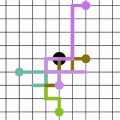Diffusion is a fundamental graph process and has been a basic building block in the study of graph clustering and graph learning tasks such as node classification. In this paper, we initiate the study of computationally efficient diffusion primitives beyond random walk. We provide an $\widetilde{O}(m)$-time randomized algorithm for the $\ell_2$-norm flow diffusion problem, obtaining the approximation factor of $1+1/\mathrm{poly}(n)$. Using the connection between its dual solution and local cut structure, we give an alternative approach for finding locally-biased low conductance cuts. It is done simply by sweeping over the dual solution vector. This algorithm demonstrates a novel way of dealing with inequality constraints in graph optimization problems. It adapts the high-level algorithmic framework of Laplacian system solvers, but requires several new tools: vertex elimination under constraints, a new family of graph ultra-sparsifiers, and accelerated proximal gradient methods with inexact proximal mapping computation.
翻译:扩散是一个基本的图表过程, 并且是研究图形群集和图表学习任务( 如节点分类) 的基本基石 。 在本文中, 我们开始对随机行走以外的计算高效扩散原始物质进行研究 。 我们为 $\ perm= 2$- norm 流扩散问题提供了 $\ plite{O} (m) 的实时随机算法, 获取了 1+1/\ mathrm{poly} (n) 的近似系数 。 使用其双向解决方案和本地切断结构之间的联系, 我们给出了寻找本地偏差低导力切换的替代方法 。 它只是通过扫描双向解析矢量来完成 。 此算法展示了处理图形优化问题中的不平等限制的新方式 。 它调整了 Laplacecian 系统解析器的高级算法框架, 但需要几种新工具: 在限制下消除顶端, 一个新组合的图形超分解器, 以及快速的纯度梯度计算方法 。




